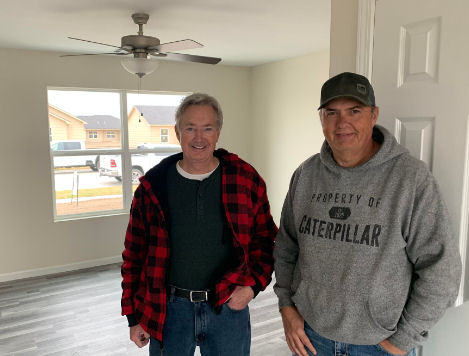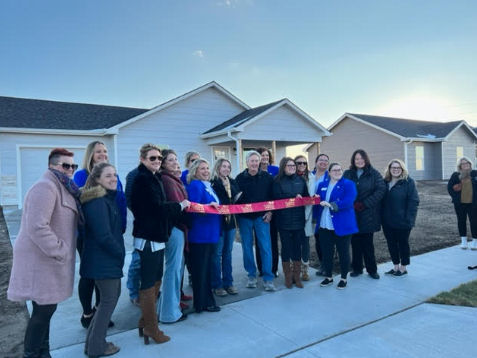Massive expansions of three big businesses in recent months show promise to boost the economies of Salina and Saline County, if all necessary pieces fall into place.
Excitement reigns in north-central Kansas as Great Plains/Kubota, Schwan’s and 1 Vision Aviation are prepped to grow.
The major employers are adding workers and luring ancillary businesses, while downtown Salina is still being gussied up and revitalized, and work on the reincarnation of the Smoky Hill River channel ensues this winter.
Those aforementioned boons are saddled with spoils, however, among them having enough places to live for the thousands gearing for relocation to north-central Kansas.
That bane has already forced some prospects for good-paying jobs to turn down offers.
“We’ve lost candidates because they don’t have a place to live. We have heard that from those employers,” said Amanda Barnett, housing and infill development AmeriCorps fellow, working in Salina.
“Quite a few have turned us down,” said Jim Sponder, CEO and owner of 1 Vision Aviation, a maintenance, repair and overhaul company in Salina.
The rapidly growing company based in Sioux City, Iowa, employs 250 in Salina, and desperately needs another 500 more mostly airframe and power plant mechanics “right now,” he said. The long-range goal is having 1,500 on staff.
There are either not enough homes or apartments to house the expected influx, or the vacancies aren’t conducive — i.e. affordable — to workforce housing. In other cases, new employees make too much to qualify for low income housing, or they’re too young for age-restricted neighborhoods.
This region is not unique, said Lauren Driscoll, Salina’s director of community and development services.
“Housing is a national problem. Literally every community in the country is experiencing this,” she said. “We haven’t produced a lot of new housing here in central Kansas for a long time.”
That is being rectified in Salina, thanks to a public-private partnership using local, state and federal grants to shave some of the cost and make the project more affordable for people and profitable for developers.
Help has so far unfolded in southeastern Salina where South View Estates has sprung up since early February, planning enough space for 108 families — in the form of single family homes and townhome duplexes, ranging in price form $179,000 to $204,000.
“This project is a great price point and some wonderful starter homes,” Driscoll said. “The product is right in line with what our housing plan states we need as a community.”
The single family homes are three-bedroom, two-bathroom, or the “Jack & Jill” setups with 1 1/2 bathrooms, said Ashley Foley, project manager. Townhomes will be available with either two bedrooms or three bedrooms with one bathroom and a one-car garage.
“We tried to use good low-maintenance materials, but at the same time what the market wants, such as granite countertops and nice black appliances,” said Stan Byquist, co-developer of the $25 million project, with Tod Roberg, both of Salina.
Some finished homes built to fit the criteria, were put on the market in mid-November.
Up to $1 million to help supplying utility infrastructure to serve the new homes, was given to the project from Saline County’s $10.532 million federal allotment from the American Rescue Plan Act. A little more than half a million dollars has been used so far at the new housing development.
“It’s a way to fill the gap between what it costs to build these units and the market rate,” Barnett said. “As good business people, developers don’t want to risk building a development and lose money when they sell the houses.”
Byquist and Roberg stepped in to help.
“The city said there was a need and we’re trying to fill it,” Roberg said.
They and other local visionaries have been busy adding housing for years, but this particular and necessary category is in short supply, Driscoll said.
“It’s really a very particular market,” she said. “Many of the new jobs coming to town would make too much to qualify for income-restricted properties.”
Roberg and Byquist have normally stayed busy building to fill high-end housing needs in Salina and Saline County.
“I could really take a little bit of everything right now; apartments or rentals, and owner-occupied units, too. We could use something in every price point,” Driscoll said.
Housing is key to finding workers, said David Disberger, executive vice president of Great Plains/Kubota, a manufacturer of equipment for agriculture, dirt working, turf maintenance and landscaping, doing business across the country and internationally. Employing more than 1,500, the Salina-based company is a mainstay in north-central Kansas.
“It’s very encouraging to see what local businesses and developers are beginning to do,” he said. “We’re pleased to see the kickoff of several construction projects in town, and thankful developers are willing to do these projects.”
More workers are an important part of the Great Plains growth strategy.
“We need to add hundreds of team members to our construction equipment division,” Disberger said, “We’re pleased to see effort being made to have housing for our current and future employees. It will benefit Great Plains and the community.”
The Schwan’s Company, employing 1,125, is well into a 400,000-square-foot expansion of it’s Tony’s Pizza plant in Salina. Up to 225 new full-time jobs will be added.
To make South View Estates happen, a Rural Housing Incentive District was formed May 3, 2021, Barnett said.
RHIDs are designed to help developers build housing within rural communities “by assisting in the financing of public improvements,” according to kansascommerce.gov.
The city and county need 2,400 workforce housing units by 2030, according to 2022 Live Salina Housing Plan Supplement (find it on the city’s website).
“(South View) supplies 108 of those. We still have a long way to go,” Barnett said.
The development commands attention, said Jerry Short, a real estate consultant with SalinaHomes.com. He joins Jessica McMillin, Jody Ryan and Morgan Powell as South View Estates listing agents, although any Realtor can sign a buyer.
“It’s gonna fill a gap in what we have available in housing in Salina,” Short said. “We’ve been getting calls and showing some units. There is interest in them.”
He thinks the homes will sell, despite the higher interest rates.
Among the positives for the development, there are no special assessment taxes for the development, thanks to it being part of a Rural Housing Incentive District, which is similar Tax Increment Financing.
The new tool for Salina and Saline County that will capture new property tax revenues generated and redirect them back to cover eligible costs the developers have incurred, according to Phillip Smith-Hanes, Saline County administrator.
Developers are able to recoup the costs of water, sewer and road infrastructure, along with other eligible costs, Driscoll said, so they don’t have to pass those expenses on to the buyer, normally in the form of special assessment taxes. There are no specials in South View.
On top of that is the Moderate Income Housing grant from from the Kansas Housing Resource Corporation to ensure 36 of the homes go to moderate income people.
A second mortgage of $5,000 is affixed to 24 of the homes that will be forgiven if the homeowner stays in the home five years. If the home is sold prior to the five years, the owner will owe a prorated amount, Driscoll said.
“It’s about keeping these homes at an affordable rate,” she said.
Roberg and Byquist praised Driscoll and city staff for priming policies to handle the housing challenge. What might normally take years was done in six months.
“We looked at the 2016 housing plan to first understand what the heck was going on,” Driscoll said.
The city hired a consultant, RDG Planning and Design of Omaha, which is known to study housing in Kansas and a multi-state region.
“We updated housing plans with fresh data for us to start making decisions, and we got out there and started hustling, talking to developers on. the phone and with the (Kansas) Department of Commerce,” she said.
City leaders have asked RDG to supply fresh numbers on a yearly basis.
“We have a developer packet on a website, a whole process to makes things as efficient as possible,” Driscoll said.
The strategy includes incentives making the Salina/Saline County attractive for developers, with industrial revenue bonds for housing and RHID to help with the cost of shared infrastructure in the development, also setting up a scoring system that set abatement percentages and length of abatements.The full adopted incentives policy can be founds on the city’s website.
“We stopped everything from being so inconsistent, and created a system,” Driscoll said. “South View was the first RHID through the hoops.”
Developers Byquist and Roberg expressed confidence in the system.
“There is some calculated risk involved,” Roberg said, “but we think it’s all gonna be fine.”
_ _ _
Courtesy Top Photo : Key players in making South View Estates a reality, gather for a ribbon cutting earlier this fall.

Developers Stan Byquist and Tod Roberg pose in the living room of a home in South View Estates during early December in southeastern Salina. – Photo by Tim Unruh



